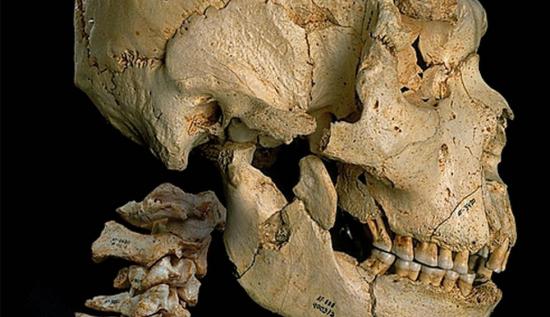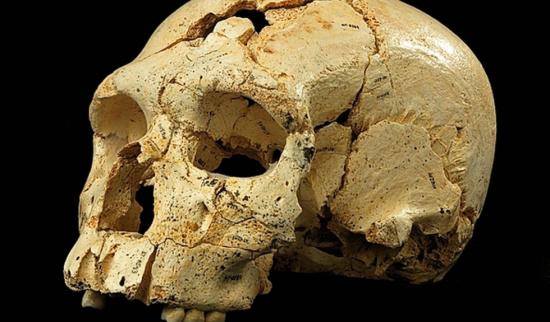Luis Miguel Ariza
Source - http://elpais.com/elpais/2014/08/25/inenglish/1408962924_960182.html?

Para bajar a la Sima de los Huesos, Juan Luis Arsuaga, uno de los tres codirectores del yacimiento de Atapuerca, desciende por una escala de 13 metros en vertical. Esta sima actuó como una trampa natural para centenares de osos que entraban a invernar en la cueva. JAVIER TRUEBA (MADRID SCIENTIFIC FILMS)
Archeologists several weeks ago closed off the entrance to the Sima de los Huesos, or Bone Pit cave, in the Atapuerca mountains in north central Spain, bringing to an end the 2014 excavation season, and with it, the search for further evidence of what seems to be a missing link between the Neanderthals and an even older human ancestor.Before Juan Luis Arsuaga, professor of paleontology at Madrid’s Complutense University and the co-director of the dig in a cave complex 15 kilometers east of the historic city of Burgos, and his team prepared to leave, he provided a guided tour of the site, leading EL PAÍS down a narrow folding ladder and pointing to the wet clay floor of the pit, around 700 meters below the earth’s surface, out of which poke tiny shards and fragments of bone. “They’re bear bones. They cover the human remains underneath,” he says.
Every summer since 1978 archeologists from around the world have been removing about 20 centimeters of clay a year from an area measuring less than one square meter, painstakingly picking out fossilized material dating back more than half a million years: “Sometimes the bones just fall apart before your eyes,” says Arsuaga.This year’s excavations have yielded around 200 hominid fossils, including ribs, vertebra, cranium fragments, and hand and foot bones. “This kind of haul is unknown anywhere else. Human fossils are very rare. If you find a tooth, it is cause for celebration,” says Arsuaga.

Juan Luis Arsuaga observa un trozo de cráneo descubierto en la campaña de excavación de 2014 en Atapuerca. JAVIER TRUEBA (MADRID SCIENTIFIC FILMS)
The team has just published a new article in journal Science that argues that 17 skulls, each around 430,000 years old, reconstructed from fragments found in the Bone Pit since 1992 have Neanderthal features. The bones suggest that some Neanderthals – which are known to have lived in Europe from 200,000 years ago until 30,000 or 40,000 years ago, when they became extinct – evolved much earlier than others. Arsuaga and his team say they could have belonged to an African species called Homo heidelbergensis. Humans are known to have been in Europe for at least 850,000 years. It is also known that an ice age around 650,000 years ago that lasted for 100,000 years made life hard for early man. But the individuals who ended up at the bottom of the Bone Pit lived during a later, warmer period.

Un emblema de Atapuerca, el cráneo 5 completo con vértebras, bautizado como Miguelón. JAVIER TRUEBA (MADRID SCIENTIFIC FILMS)
The skulls found in the Bone Pit have Neanderthal-like teeth and jaw structures, as well as brows and nasal openings. But unlike the Neanderthal remains found so far, their braincases are small. “We could call them the grandfathers of the Neanderthals,” says Arsuaga. It’s been a productive year at Atapuerca. In February, Arsuaga published the results of work with Dr Svante Pääbo of the Max Planck Society, who has developed new methods for recovering and sequencing badly eroded DNA.

Cráneo 17 Reconstrucción de fragmentos hallados en Atapuerca JAVIER TRUEBA (MADRID SCIENTIFIC FILMS)
He and his team applied their new techniques to a femur from the Bone Pit site to sequence their mitochondrial DNA (mtDNA). They discovered that the people who lived in Atapuerca about 400,000 years ago were related to the Denisovans, an ancient human species that lived in Siberia at the same time as Neanderthals, and survived up until around 40,000 years ago. Analysis of a finger bone fragment found in the Denisova cave in the Altai mountains in Siberia established that it was neither modern human nor Neanderthal, but a different hominid. But how to explain the link between the Atapuerca people and the Denisovans? One theory is that Homo heidelbergensis, whose origins date back 1.3 million years, was the grandfather of the Neanderthals, the Denisovans, and us. The hominids who migrated to Europe half a million years ago produced the Denisovans and Neanderthals. The African branch of the family, would eventually develop into Homo sapiens around 50,000 years ago, which then competed with Neanderthals, eventually contributing to their extinction. Until recently, Arsuaga believed that modern humans had no Neanderthal genes. But genetics has shown that there was some interbreeding between the two species. As a result of which, we have some Neanderthal genes, albeit a tiny amount. “Water, even if it is 2.5 percent vinegar, is still basically water,” he argues. “And Africans have no trace of Neanderthal genes.”But Neanderthal experts João Zilhão and Erik Trinkaus have a very different idea. Long before the genetic evidence appeared, they were arguing that there was interbreeding between Neanderthals and humans, and that the dividing line between the two species is hard to establish. Earlier this year Benjamin Vernot and Joshua M. Akey of Washington State University in Seattle showed through genetic analysis of 665 Europeans and east Asians that they all had around 20 percent of the Neanderthal genome (particularly genes related to hair, nails, and skin color).
The Atapuerca complex includes other caves and galleries that have yielded finds from as recently as the fourth century BC, and will provide further clues as to our origins. In May, scientists found the complete skeleton of an eight-year-old child who died from rickets. Today, there is electric lighting, but the cave system remains a difficult place to navigate. Arsuaga points out a gallery that leads to another cave, the Elephant Pit, where in 2007 the team found the jaw bone of a hominid who lived here at least 1.3 million years ago: the oldest example of human existence in western Europe. “It’s an incredible feeling,” says José María Bermúdez de Castro, one of the co-directors at Atapuerca. “It’s like escaping from the real world to another, strange environment.” He says he sometimes turns his light off and sits in the dark and the silence: “The absence of any noise is overwhelming.” This is a place where time has stopped. But a quarter of a century ago when we visited, it had been barely explored. In 1987, we witnessed the making of an opening in the Cyclops Gallery that led back up to the surface, making it easier for the archeologists to remove their finds. In 1993 came the discovery of three skulls, one of which made the cover of journal Nature. We continue descending into the cave system, holding tightly on to our metal rope ladder. Arsuaga pauses to point out a pile of rocks: “We’re going to date them. If they are less than 400,000 years old, it means they were here after the hominids, and that there was an entrance here. If they are older, it means the cave would already have been sealed. And if they are contemporary with the hominids…” He prefers not to get his hopes up. We still have to descend a further 10 meters to reach the next pit, the so-called Treasure Room, a tiny rectangle measuring seven meters by three.

Frontal y maxilar del Homo antecessor, nueva especie de homínido cuyo estudio ha propuesto que fue ancestro de los neandertales y humanos. JAVIER TRUEBA (MADRID SCIENTIFIC FILMS)
The presence of bear bones slows down the work. Arsuaga says they probably ended up down here after falling while looking for somewhere to hibernate. But what are the human remains doing down here? The team believes that they were thrown down as part of a primitive burial process. A hand ax found at the Gran Dolina site led experts to link that large cave with the Homo heidelbergensis remains found in the Bone Pit. Another object found at Atapuerca, a one-million-year-old sandstone chopping tool, led experts to hypothesize a link between 800,000-year-old Homo heidelbergensis remains with the oldest hominid remains at the site (dating back as far as 1.2 million years). Arsuaga says he will continue to excavate the cave system, and believes that only a third of the human remains down here have been found. He’s hopeful he’ll find Neanderthal remains in the coming years. But more likely is the appearance of more remains related to the possible missing link between modern humans and Neanderthals.
In 1997, a team led by Eudald Carbonell dug up part of the face and jaw of a 14-year-old child, along with remains from another aged 10. It also found 36 fragments belonging to six individuals, along with flint tools in the Gran Dolina chamber, which has its own opening to the outside world. Examination of the 14-year-old’s remains suggested that he had probably been eaten by his fellow cave-dwellers around 780,000 years ago. But what really impressed the researchers were the physical similarities with modern humans, says José María Bermúdez Castro. “Given their age, we thought that they would look more like Homo erectus,” he adds.
The Atapuerca team then suggested to Science that the remains belonged to a new species, which it dubbedHomo antecessor, arguing that it might have belonged to a group of hominids that left Africa to colonize Europe, and that were in fact the ancestors of the Neanderthals. Meanwhile, hominids living in Africa could have evolved intoHomo sapiens. The species would therefore be a missing link between Neanderthals and humans, albeit from different periods and continents. Since then, Atapuerca has yielded some 160 fossilized human remains; Bermúdez de Castro says that Gran Dolina probably has more to offer up, and dates back up to 950,000 years. Ignacio Martínez, who works with Arsuaga, says the team’s thesis holds water. “Right now, Homo antecessor is in the scientific fridge, because it is a very fragile species, but the debate about it is serious.” Chris Stringer of London’s Natural History Museum says it is possible thatHomo antecessor is an ancestor of modern humans and Neanderthals, but “not the last”. He believes that the genetic data suggests that our common ancestor lived 600,000 years ago, before the Gran Dolina hominid, and that this would have to be Homo heidelbergensis, who lived around that time, or maybe another species such as Homo rhodesiensis, remains of whom have been found in Africa, Europe and Asia. “But we don’t know how these two species originated. They could have derived from Homo antecessor, and if so, then we would have to include it in our genealogy, but we need more information before we can do that,” says Stringer. But Spanish paleontologist Emiliano Aguirre, who set up the Atapuerca project in 1977, and led it until 1990, doesn’t accept the missing link theory: “I have always been wary of accepting new species.” Which doesn’t mean that the remains found in Gran Dolina aren’t something very special. “If this really is something different, there are so many remains in Gran Dolina and they belong to an age about which we know very little, that we could begin to talk about using new terminology,” he says. Aguirre is less concerned at the moment about whether a new species has been found. These hominids are special, and seem to possess modern and primitive features, he says. Atapuerca will continue to provide further evidence about modern humanity’s origins that may clear up this puzzle, or may spark new debate about where we came from.